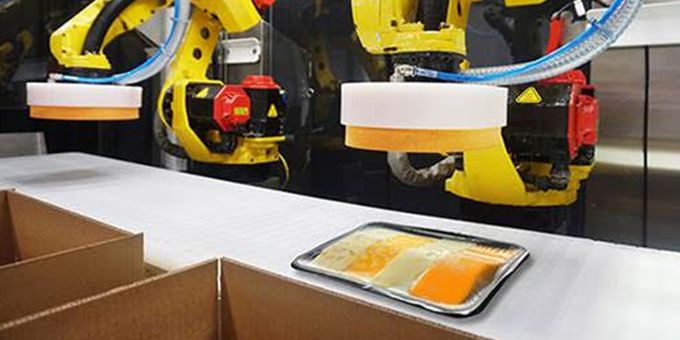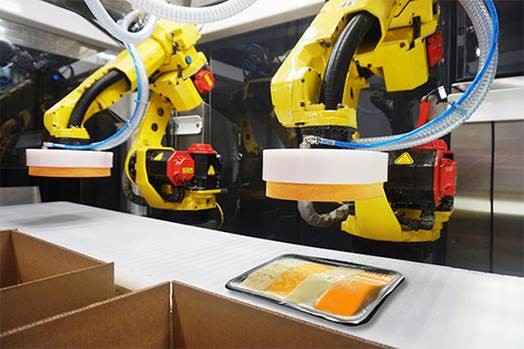Heavy washdown and harsh chemical solutions used to clean robots in FDA and USDA sanitary environments for food processing can impact the robot finish, as well as leave condensation on robotic machinery that could potentially reach food products being handled.
 Robotic Washdown in Food-Handling Environments
Robotic Washdown in Food-Handling Environments

Erik Grinnell, Vice President of Automation | Quest Industrial
Manufacturers are increasingly utilizing robots suitable for handling unpacked goods, creating new opportunities for the direct and indirect handling of foods. Food processing robotic automation delivers consistently better quality, improves picking and handling times and increases output by speeding up processes. These robotic pick-and-place systems are low maintenance, flexible and reconfigurable, and especially beneficial in manufacturing and packaging applications when dealing with food products.
Utilizing 5- and 6-axis articulating-arm robots, delta-style high-speed robots, and 4-axis SCARA (Selective Compliance Articulated Robot Arm) robots, a wide range of applications are possible for food pick-and-place, sorting and inter-plant routing for product handling. High-speed pick-and-place robots, like the FANUC M Series delta-style robot, or the FANUC SR Series SCARA robots are perfectly suited for picking food products and placing them into packaging with excellent repeatability performance and high-level accuracy.
Much of the technology of pick-and-place with robots is involved in engineering end of arm tooling (EOAT), used to pick up the items. A crucial aspect of robotic technology, EOAT refers to the equipment that interacts with parts and components at the end of a robotic arm. The design of clamping and vacuum-based arm tool picking solutions contributes to establishing precision product placement and handling, and successful pick rates without product damage.
Designing Robotics for Cleanliness and Sanitation
Robotic systems used for the direct and indirect handling of foods are designed to meet heavy wash-down criteria, where cleanliness and sanitation are a critical factor. Heavy wash-down robotics are used where it is anticipated that foods will come in direct contact with the robot in the normal process of product movement. The robot should be designed to endure heavy exposure to water applied with a high-pressure, high-volume hose, along with cleaning agents, on a daily basis.
The design of the robot should be completely free of crevices, ledges and dead spots, so that liquid – either in slurry, condensation or during washdown – is completely drainable with no areas where liquid can settle. Surfaces should be designed to be convex, rounded or inclined to 45 degrees to actively promote the flow rate of product spillage and cleaning solutions. All tubing closed-welded, and bolts, studs, mounting plates, brackets, junction boxes, name plates, end caps, sleeves and other such items are required to be continuously welded to the surface.
Robotics used in food ingredient manufacturing must conform to FDA and National Sanitation Foundation International (NSF) standards, as well as those specified by A-3 Sanitary Standards Inc. Each has a slightly different approach to the task of making equipment safe for food production.
More recently, also influencing the design of robotics used in food handling is the European Hygienic Engineering & Design Group (EHEDG), which prepares scientific and technical guidelines on all aspects of hygienic design requirements for equipment used in food sectors.
With a focus on improving product safety, process efficacy and production efficiencies, the latest guidelines from EHEDG recommend that robotics used in the processing of food be designed to hygienic standards exceeding conventional 3-A Sanitary Standards, essentially to better ensure the microbiological safety of the end product. Robotics manufacturers in the United States have been increasingly looking to EHEDG for guidance in manufacturing equipment that more completely meets these escalating hygienic requirements.
EHEDG hygienic design recommendations for robotics systems more completely assure cleanability and the elimination of hollow body components that may provide micro-niches for microbial proliferation. This extends to each part, module and unit that makes up the robotic processing equipment. The physical design of enclosures and surroundings must also be considered as an integral part of the overall hygienic system of the robot. This is because they influence and affect the efficiency and effectiveness of the design, installation, operation and maintenance of hygienic robotic processes.
Validation procedures and hygienic risk assessments therefore include consideration of such matters as cleanability of surfaces, air systems and drains, flow of people and materials and products, and ease of robot access and maintenance.
Heavy Washdown, Harsh Chemicals
Food plants are naturally messy and at high risk for bacteria and fungus growth. The immediate focus for processing applications like dairy, meat, and poultry is that pathogens and contaminants have no hiding place in which to multiply and become a sanitary concern. Butmachinery, including robotics, typically does not appreciate high-pressure spray, heat and harsh chemicals. Designers, as a result, must take added measures to make sure every component on the system can withstand whatever the cleaning process might entail.
Robotic systems rely on chemical treatments like chlorine washes and ethylene gas, with water, for washdown. There are challenges to a good washdown, however: a) the skill level and training of the individual doing the washing; and 2) the chemical mixture. If not mixed in appropriate proportions, cleaning agents can be either too strong or too weak, and can degrade the level of sanitation or damage the robotic system.
Heavy washdown and harsh chemical solutions used to clean robots in FDA and USDA sanitary environments for food processing can impact the robot finish, as well as leave condensation on robotic machinery that could potentially reach food products being handled. Two solutions have been developed to successfully overcome these challenges – Qleen® Coat robotic coating, and Qleen® Armor specialized robotic drip management, both developed by Quest Industrial. Both solutions were developed to enable robotic automation for the rigorous environments in the cheese and dairy industry.
Qleen® Coat Robotic Coating
Historically, Quest found that many food processors were ready for robotic automation, but could not automate because the robots finish was not suitable for the harsh conditions and cleaning processes used in FDA and USDA sanitary environments. Consequently, Qleen Coat Robotic Coating was developed while seeing the effects of cleaning practices and harsh cleaning solutions on the standard factory finish of robots operating in the food industry.
Qleen Coat uses several different polymers applied to the assembled robot, that help resist damage from cleaning processes that use strong acids, bases, etc. This coating, paired with Quest's suggested cleaning methods, not only protects the finish, but also gives the robot a bright, quality sheen.

Qleen Coat uses several different polymers applied to the assembled robot, that help resist damage from cleaning processes. (Image courtesy Quest Industrial)
This is a five-step process, a specialized very-thick epoxy coating, applied by hand, with specialized enhanced polymers to get the best life out of the epoxy. The coating does not make the robots waterproof, but much more chemical resistant.
Qleen® Armor Specialized Robotic Drip Management
To further enable robotic automation in food safe areas, Quest engineered drip trays, or "robotic armor", which catch any fluid or condensate, and keep it contained and away from the food zones.
Called the Qleen Armor specialized robotic drip-management solution, it is a thermoformed, custom-molded drip tray attached to the robot arm, which keeps the robot arm out of the food-safe zone. Essentially, the drip tray is there is catch any residual water, chemical, grease, oil, anything that can come in contact with the food. It gets held in the drip tray before anything could ever get dripped on the food. The drip tray can be washed separate from the robot. Qleen Coat and Qleen Armor support 3-A Sanitary, USDA and FDA compliance, and incorporate those requirements within the equipment to help robotic systems pass safety and quality standards. This functionality applies to any industry subjecting robots to harsh washdown conditions or requiring the containment of fluids.
Robotic Systems Optimized for Cleanliness
As food safety standards become more stringent for the manufacturing of food products so has the necessity for more hygienic processing systems.
Design decisions impact more than just cleanability. They also determine how long it takes to clean a piece of equipment. The goal is to minimize sanitation cycle time without compromising effectiveness. When machines are down for cleaning, they are not producing products or a return on capital.
Where special plant conditions and sanitation requirements are known in advance, it is possible to introduce certain design features to ensure hygienic compatibility with other equipment and systems such as electrical, hydraulics, steam, air and water. This represents the big picture for use of robotics in food production operations, where the hygienic environment extends out from the robot into the affiliated manufacturing facility.
This need for heightened cleanliness in food manufacturing has been supported by EHEDG, FDA, NSF and other regulatory and standards setting organizations. Although manufacturers are sometimes slow to adapt to industry needs, some robotics manufacturers, such as Quest Industrial, have taken the initiative to move forward and integrate more stringent hygienic recommendations – such as Qleen® Coat robotic coating, and Qleen® Armor specialized robotic drip management – into their robotic systems.
About Quest Industrial
Quest Industrial (Quest) is a manufacturer of turn-key industrial automation equipment focusing on robotics and vision-guidance serving food, beverage, dairy, and other industries needing to optimize floor space, expand operations with accuracy and consistency, and improve overall production line flexibility and efficiency.
About ProMach
ProMach is a family of best-in-class packaging solution brands serving manufacturers of all sizes and geographies in the food, beverage, pharmaceutical, personal care, and household and industrial goods industries. ProMach brands operate across the entire packaging spectrum: filling and capping, flexibles, pharma, product handling, labeling and coding, and end of line.
The content & opinions in this article are the author’s and do not necessarily represent the views of RoboticsTomorrow
Comments (0)
This post does not have any comments. Be the first to leave a comment below.
Featured Product

